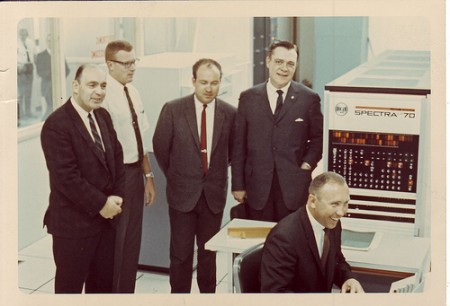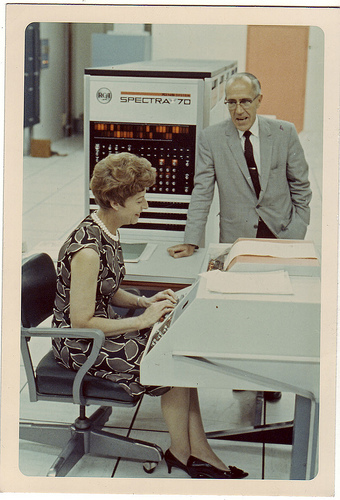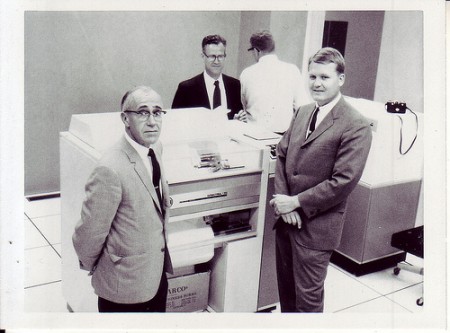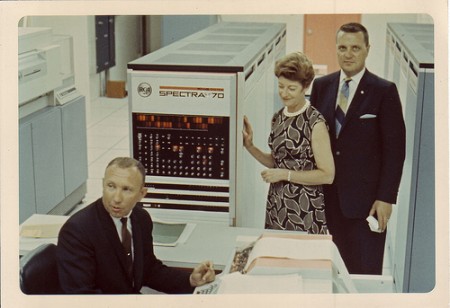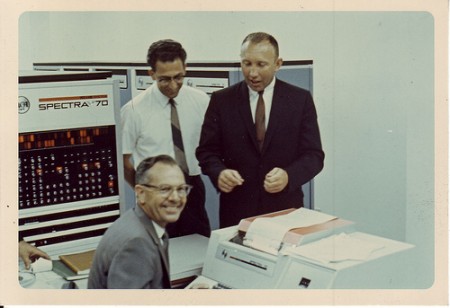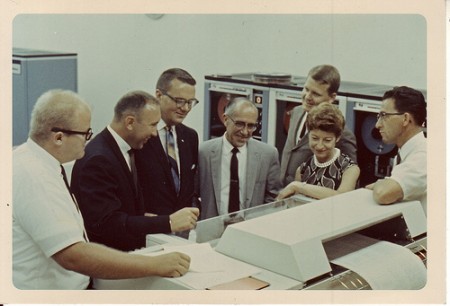Utah Department of Employment Security and Their RCA Spectra 70
A while back, I wrote an entry about some photos I found in an antique store:
Back then, I guessed that these pictures were from the Corporate Office for the computer company itself:
If you notice, the 1965 brochure doesn’t mention a Salt Lake City office, but the 1968 brochure does. Considering that RCA stopped selling the Spectra70 in 1970, I suspect these photos are from the opening of the Salt Lake City office.
I was WRONG! I am so lucky, because Mike Dodas, who worked at the Utah Department of Employment Security during the 70s recognized the people in the photos! He emailed me and I asked him a ton of questions. Here is his response!
December 15, 2014
Dear Laura,
I was very happy to hear back from you! It’s really great to be able to talk to someone about these systems from the past with someone who is interested. I guess I’ll start with your questions, first. In those early days, we were the Utah Department of Employment Security, which was abbreviated (nation-wide) to Job Service. Today it is the Utah Department of Workforce Service. I will refer to it as Job Service.
I happened across your photos as I was looking for information on vintage mainframe computers. I was really stunned to see them. There’s very little out there on RCA systems. IBM’s dominance was so great, it’s no wonder why the other competitors dropped out of the market.
The woman in the pictures you asked about was in charge of the entire ADP (ITS) department. Her name was Edna Smith. And your perception of her being a rock star was a pretty good observation. I admired her a great deal. Her appearance was always as lovely, every day, as she looks in the photos. She started with Job Service in the mid 1940’s and retired in the late 1970’s. Edna came through the ranks through the years. Some of the early “advanced” work she did was hand-wiring the boards that ran the old unit record equipment, like the punched card collator and reproducer, which was still in heavy use at the time I started. She ran a tight ship and had an impeccable reputation within the U.S. Department of Labor and other state Job Service organizations.
Most of the people in the photos are employees of Job Service and a few of the others are RCA reps. They have all passed on, some of them many years ago. A few of the people in the photos are individuals I worked with for quite a long time. I don’t know much prior to the Spectra/45’s, but I think Job Service used an IBM 1401 system. The first system I had exposure to was an IBM 1130, a very small system.
The photos you have appear to be the very early installation. I would suspect that it was just in the process of being staffed and programmed. What the photos don’t show is that a little later on, that same room would contain an additional Spectra/45 system plus additional equipment. So there were actually a pair of Spectra/45’s. I think RCA considered our installation somewhat of a flag-ship, as they dedicated a full-time engineer to our site, who later became a full-time employee of Job Service.
This system primarily came about because of a grant the Utah Job Service was given by the U.S. Department of Labor to develop an automated job placement system. Not only was this accomplished, but we also were doing something very rare at the time–on-line terminal communications. The local offices could access client information from a terminal at all of our local offices. This was a very advanced function in the late 1960’s. I believe RCA was actually ahead of IBM and CICS in this area at the time. One of the Spectra/45’s was dedicated to processing on-line transactions during the day and the second ‘45 was used for batch processing. One very bright individual programmed and maintained the entire on-line system, which was written completely in assembler language. We had some of the finest, dedicated IT staff you could ever hope to have throughout the years. Some things that made working on these systems difficult was that there were few or no tools available to assist in problem resolution. If a program crashed, you had to wade through a lengthy printed memory dump to find the offending data error or instruction. Of course, the assembler language programmers loved and thrived on hexadecimal!
The Spectra/45 systems were multi-processing systems that had 256k of memory, tape drives, disk drives, high-speed printers, punch unit and high-speed card readers and communications multiplexer. I don’t think people realize today the throughput those machines had at processing large volumes of real data. We ran two shifts to process our work and used the systems for our exclusive use. We were one of only a few state department with their own data center. We processed all employment services, unemployment insurance payments, employer contributions, Job Service payroll and all state and federal reports, accounting and statistical functions.
Around 1974, the two Spectra/45 systems were replaced with one RCA Spectra 70/7 unit. By then, Univac had acquired RCA. The 70/7 ran the same operating system as the 70/45’s, which was TDOS/22 and TDOS/23. The 70/7 had 512k memory and was later upgraded to 1 meg. Later on, the 70/7’s operating system was converted to Univac’s VS/9. The conversion to VS/9 was astonishingly difficult, because we had to do the conversion on the same machine used for production. Staff worked at night on the conversion running VS/9 and then the system ran TDOS/23 during the day until the conversion was complete. Every JCL had to be written from scratch and every program required some modification and all required recompilation. All disk files had to be reloaded–plus testing. What a nightmare. In the end, it was a very good system. VS/9 was probably more advanced than anything IBM had at the time. Virtual memory, on- line access for programmers (similar to TSO), which started our transition away from punched cards. Both operating system also had input processing ques and print spooling capabilities. We were even using satellite communications to transmit inter- state claims information. This was actually called the Internet, which I believe the Feds gave way to what is currently the Internet.
As for me, I started with Job Service in 1971. I did not start in the Data Processing Department, but transferred to it around 1973. My first position was in Data Control. It was a unit that prepared the runs for processing on the computer and distributed the completed work. We used sorters, collators and various other unit record equipment, many of them programmed with wired boards–my God, how old is that! After about 15 months in Data Control, I transferred to the computer room as a computer operator. The Spectra 70/7 had just been in a short time by then. Of all the jobs I had at Job Service, this was the most enjoyable. I just loved working at this job and with the other people in this section. Computer operators during this time frame had a lot of responsibility. You really had to know a lot about the work and what you were doing and how to recover and re-run. A bad computer operator could really cause a lot of problems. There was a lot to get done and you were constantly busy. It’s a little amusing when I read how others describe the mainframes of that era as “persnickety” and being down quite a bit. I didn’t find that to be true at all. Our up-time was very good and everything was a lot more straight-forward to deal with than today. We ran some very complex systems, even by today’s standards, on machines with limited resources and still achieved remarkable throughput results. Yes, there were punched cards, lots of paper and a typewriter console to communicate with the cpu–but it all worked very well, nevertheless. I have to say, though, that I never missed the punched cards. Between messing them up by dropping them, or having the reader chew them up and lugging the damn things around, I was glad to see them go.
After a few years as an operator, I was asked to fill a new position to handle special reporting requests and trouble-shoot problems. I liked this position because I was doing some programming, plus I was still very close to the operations side of things. During this time, we also started our migration to an IBM mainframe environment. All of IBM’s competitors had (or were) biting the dust, so we went in IBM’s direction.
Around 1980, I transferred into the systems and programming area. I worked on most everything, in one way or another, as a programmer and also an analyst. I was a manager over the programmers for a time and was also fortunate to be heavily involved with evaluating and brining in new technology. Around 1995-1996, we moved from the Social Avenue location in Salt Lake City to a new building that housed Administrative Services for Job Service. About 1998, we lost our own data center and merged with the State of Utah’s ITS system. The merge was one of the last large projects I was in charge of coordinating, along with Y2k, before I retired in 2001. It was sad for me to see almost 40 years of history go. Even though I have worked on other platforms, the mainframe will always be my first choice.
If there is anything else you would like to know or if I have missed something, please let me know. You can use any of the information I have provided as you wish. Years ago, we use to have an audio-visual department that would take pictures and films of various items of interest within Job Service. I don’t know what happened to all that information over the years. I know they took photos and films of the data center. It was probably trashed. If not, I wouldn’t even know where to begin to look for it.
Thanks so much for your interest!
Sincerely,
Mike Dodas
Salt Lake City, UT
Thank you, Mike, for sharing all this information with us! I love hearing about the old systems and I believe all of it should be saved and archived. Wishing you the best in all you do!
